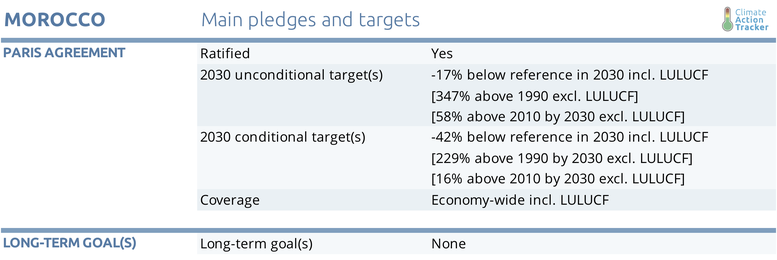Country summary
Overview
Morocco’s climate pledge for 2030 is at present rated “1.5˚C Paris Agreement-compatible”—however there are significant concerns over the development of coal. In December 2018, Morocco started operating a new 1.4 GW coal-fired power plant, which alone could supply up to a fourth of Morocco’s electricity consumption. Another 1.3 GW coal-fired power plant is expected to come online in 2023–2024.
Coal growth in Morocco is inconsistent with the Paris Agreement. In Paris-compatible pathways for the Middle East and Africa region, coal-based power generation is reduced by 80% in 2030 compared to 2010 levels, leading to a phase-out by 2034. A shift away from coal is essential for Morocco to achieve its 2030 Paris Agreement targets and avoid creating stranded assets in carbon-intensive infrastructure.
Morocco’s planned climate action under its National Energy Strategy includes implementing an ambitious target of 42% installed electricity capacity from renewable energy by 2020, increasing to 52% by 2030, which it is on track to achieve. Despite this, current policies are trending towards the top end of the “1.5°C compatible” range in 2030. A lock in of coal could exacerbate this and lead to an adverse change in rating.
The development of coal is not consistent with the mitigation objectives of the Paris Agreement, which require a full decarbonisation of the power sector. As a comparably poor country with low historical GHG emissions, Morocco should receive support from other countries to enable it to transition to a Paris-compatible pathway.
Despite the negative trend in the power sector due to coal, Morocco’s Paris Agreement target is within the range of what is considered to be a “1.5°C compatible” fair share of global effort. This means that Morocco’s unconditional Paris Agreement climate commitment in 2030, even while it allows the country’s total emissions to increase, is consistent with holding warming well below 2°C, and limiting warming to 1.5°C, based on its historical responsibility and its capability. Morocco’s conditional climate commitment would stop greenhouse gas emission growth, and asks for increased international financial support to implement this target.
In 2019, Morocco issued its 2030 National Climate Plan. The strategy confirms the climate objective set under Morocco’s Paris Agreement pledge and lays out measures to enhance climate governance, notably by creating a National Commission on Climate Change, by improving inter-sectoral coordination, and by involving non-governmental organisations in decision-making.

Morocco’s NDC submission includes detailed information on activities currently under implementation and planned measures to achieve its unconditional and conditional NDC targets. The CAT has assessed in detail the impact of mitigation actions currently under implementation for Morocco. We find it very close to meeting its unconditional NDC targets under current policies due to the ambitious capacity extension of solar, wind and hydro energy. However, it would need to implement additional policies to reach its conditional NDC target by 2030.

With currently implemented policies, we expect Morocco’s GHG emissions to be 153 MtCO2e in 2030 excluding LULUCF (200% above 2005 levels and 371% above 1990 levels). This is higher than both the unconditional and conditional NDC pledges.
In December 2018, Morocco commissioned a 1.4 GW coal-fired power plant, adding to an already high consumption of coal-based electricity. In 2017, coal generated over half of Morocco’s total electricity. Morocco is also in the process of building yet another coal power plant: the 1.3 GW plant is expected to be operational in 2023–2024.
This goes against the developments needed to stay below the 1.5°C temperature goal of the Paris Agreement: by 2040 coal-based electricity needs to be phased out globally, and much earlier for many regions. While Morocco’s climate pledge and current policy projections are within the range of what is considered to be a fair share of global effort, they are not consistent with the need to phase out coal-fired power plants under the Paris Agreement.
At the same time, there has also been an important renewable energy development in recent years. By 2030, Morocco aims to have 52% of renewable energy in its total installed electricity production capacity. In 2018, the share of renewable energy in installed capacity had already reached close to 34% and Morocco is on track for meeting this objective.
By 2020, Morocco aims to have 2 GW of installed capacity for wind, solar and hydroelectric energy each. At the end of 2018, it had installed 1.2 GW of wind, 0.7 GW of solar and 1.8 GW of hydropower. We expect Morocco to reach the 2020 objectives for installed renewable energy capacity.
Further analysis
Latest publications
Stay informed
Subscribe to our newsletter




